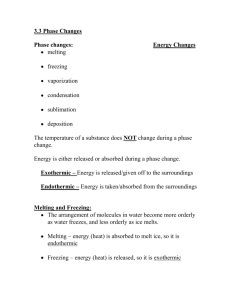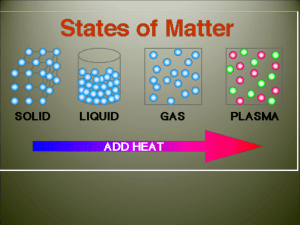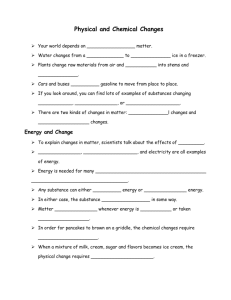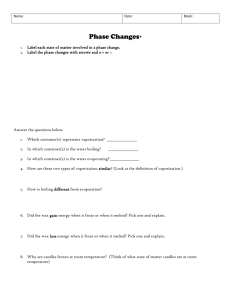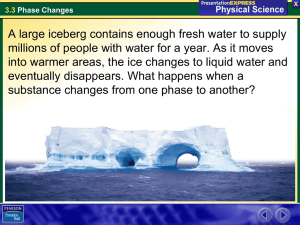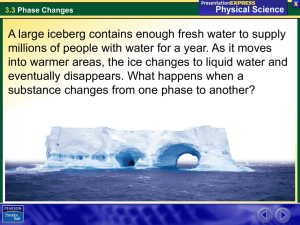3.3 - Phase Changes
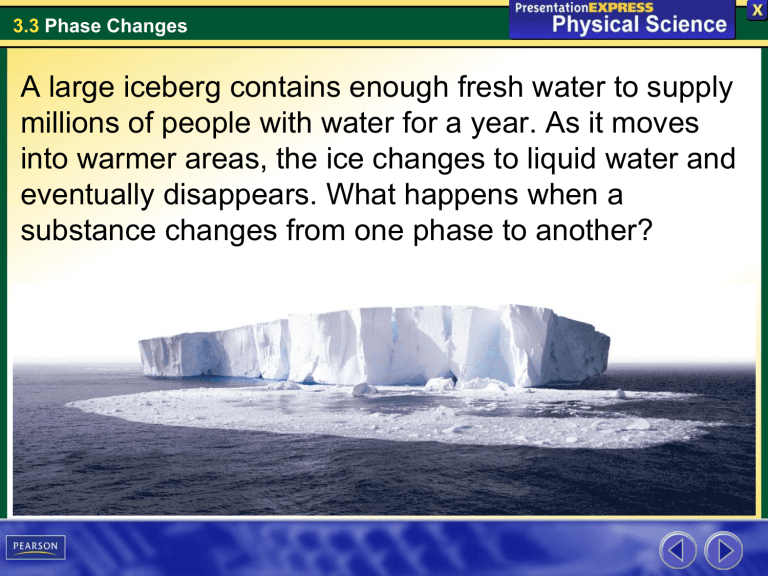
3.3 Phase Changes
A large iceberg contains enough fresh water to supply millions of people with water for a year. As it moves into warmer areas, the ice changes to liquid water and eventually disappears. What happens when a substance changes from one phase to another?
3.3 Phase Changes
Charactaristics of Phase Changes
When at least two states of the same substance are present, scientists describe each different state as a phase. A phase change is the reversible physical change that occurs when a substance changes from one state of matter to another.
Melting, freezing, vaporization, condensation, sublimation, and deposition are six common phase changes.
3.3 Phase Changes
Charactaristics of Phase Changes
This diagram lists six physical changes that can occur among the solid, liquid, and gaseous phases of a substance. Each arrow in the diagram represents a different phase change. All phase changes share certain characteristics related to energy and temperature.
3.3 Phase Changes
Charactaristics of Phase Changes
What happens to a substance’s temperature and a system’s energy during a phase change?
3.3 Phase Changes
Charactaristics of Phase Changes
Temperature and Phase Changes
One way to recognize a phase change is by measuring the temperature of a substance as it is heated or cooled.
The temperature of a substance does not change during a phase change.
3.3 Phase Changes
Charactaristics of Phase Changes
Energy and Phase Changes
During a phase change, energy is transferred between a substance and its surroundings. The direction of the transfer depends on the type of phase change.
Energy is either absorbed or released during a phase change.
3.3 Phase Changes
Charactaristics of Phase Changes
This ice sculpture of a dog sled was carved at a winter fair in
Fairbanks, Alaska. The ice sculpture will start to melt if the temperature rises above 0 °C or sunlight shines directly on the ice.
3.3 Phase Changes
Charactaristics of Phase Changes
During an endothermic change, the system absorbs energy from its surroundings. Melting is an example of an endothermic change.
One gram of ice absorbs 334 joules (J) of energy as it melts. This amount of energy is the heat of fusion for water. The heat of fusion varies from substance to substance.
3.3 Phase Changes
Charactaristics of Phase Changes
One gram of water releases 334 joules of energy to its surroundings as it freezes, the same amount of energy that is absorbed when one gram of ice melts.
As water freezes, it releases heat. The flow of heat slows the drop in temperature and helps protect the crops from damage. During an exothermic change, the system releases energy to its surroundings. Freezing is an example of an exothermic change.
3.3 Phase Changes
Melting and Freezing
Melting
Each water molecule contains two hydrogen atoms and one oxygen atom. In ice, attractions between water molecules keep the molecules in fixed positions.
Any energy gained by the water after a phase change increases the average kinetic energy of the molecules, and the temperature rises.
3.3 Phase Changes
Melting and Freezing
Freezing
Often, people think of cold temperatures when they hear the term freezing. But substances that are solids at room temperature can freeze at temperatures that are quite high. For example, silicon freezes at 1412 ° C (2574 ° F).
Any energy removed after the freezing is complete decreases the average kinetic energy of the molecules, and the temperature drops.
3.3 Phase Changes
Vaporization and Condensation
The phase change in which a substance changes from a liquid into a gas is vaporization.
• Vaporization is an endothermic process.
• One gram of water gains 2261 joules of energy when it vaporizes.
• This amount of energy is the heat of vaporization for water. The heat of vaporization varies from substance to substance.
3.3 Phase Changes
Vaporization and Condensation
Evaporation
After a rain shower on a sunny, warm day, you may notice puddles of water.
After a few hours, the puddles may be gone due to evaporation.
Evaporation changes a substance from a liquid to a gas at temperatures below the substance’s boiling point.
3.3 Phase Changes
Vaporization and Condensation
Evaporation takes place at the surface of a liquid and occurs at temperatures below the boiling point.
3.3 Phase Changes
Vaporization and Condensation
Condensation
Condensation is the phase change in which a substance changes from a gas or vapor to a liquid.
Condensation is an exothermic process.
Condensation is responsible for morning dew and the “fog” that forms on a mirror when you take a shower.
3.3 Phase Changes
Sublimation and Deposition
Where does the name dry ice come from? Dry ice is the common name for the solid form of carbon dioxide. Solid carbon dioxide does not form a liquid as its temperature rises. At room temperature, dry ice can directly change from a solid to a colorless gas.
• Sublimation is the phase change in which a substance changes from a solid to a gas or vapor without changing to a liquid first.
• Sublimation is an endothermic change.
• As dry ice sublimes, the cold carbon dioxide vapor causes water vapor in the air to condense and form clouds.
3.3 Phase Changes
Sublimation and Deposition
When a gas or vapor changes directly into a solid without first changing to a liquid, the phase change is called deposition. This exothermic phase change is the reverse of sublimation.
Deposition causes frost to form on windows. When water vapor in the air comes in contact with cold window glass, the water vapor loses enough kinetic energy to change directly from a gas to a solid.
